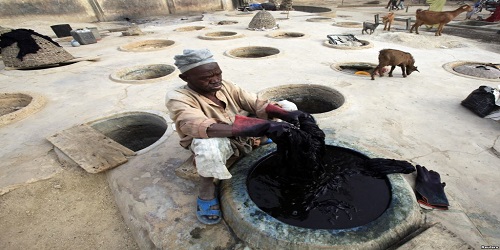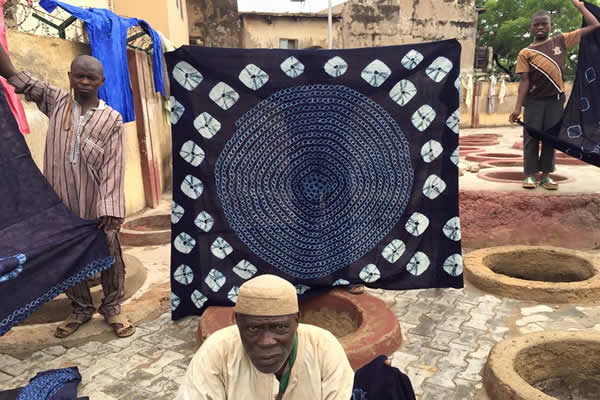
The Kofar Matar Dye Pits are a very historical place for the people of Kano. Established in 1498, the Kofar Matar pits situated in the city centre, goes as way back as 500yrs plus. It has been constantly in use ever since, and a lot of tourists come from all over the world to see it. Interestingly, they still use the same method they did use in those days.
The Kano indigo-vegetable dyeing pits are one of the most fascinating aspects of the old city. Various designs are folded into the material before dyeing and the fabric is often beaten to achieve the shiny, decent appearance. The techniques employed to obtain this look are unmatched around the world. And, although the methods they use are ancient, these lush works of art on fabric have remained extremely popular and have continued to be in great demand.
There were dyeing pits in Zaria as well as in Kano those days when they were all still at use. Today, only the famous Kofar Mata pits of Kano have survived – they have also become a much liked tourist attraction. Tourists are delighted to know that the pits they are looking at were actually founded in 1498 and the dying process has not changed in centuries.
The Tuaregs have always been good customers of the Zango fabrics. They are also known as the "Blue Men of the Desert" due to the fact that for them, the indigo fabric is left natural after the dye and not fixed with salt and vinegar so that when it is washed, it dyes their faces and hands blue. Quite beautiful, you’ll say.

On just a single visit, one may not easily appreciate the efforts that are being put in to produce the final work on a fabric from the pits. It is an amazing trip to take to the famous Kano dyeing pit where clothes that originally came in plain white colours are dyed and transformed into patches of colours, patterns and designs.
At the entrance of the Kofar Mata Dyeing Pits, hordes of activities are in full swing.Girls and women also hawk their goods which include some gourds of fresh nono (fresh cow milk) sitting pretty on their heads, others also hawk kola nuts, groundnuts, and other items.
The Kano dyeing pit, which was until recent years, open and unguarded is completely cordoned off from public view. Unless you walk into the place, it is not possible to see the ancient structure where young men and women sweat it out in the scorching sun dyeing cloths.




